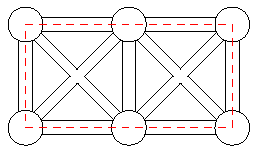poj1450
来源:互联网 发布:汽车外观设计软件下载 编辑:程序博客网 时间:2024/05/21 06:57
Gridland
Time Limit: 1000MS Memory Limit: 10000KTotal Submissions: 8253 Accepted: 4181
Description
Background
For years, computer scientists have been trying to find efficient solutions to different computing problems. For some of them efficient algorithms are already available, these are the "easy" problems like sorting, evaluating a polynomial or finding the shortest path in a graph. For the "hard" ones only exponential-time algorithms are known. The traveling-salesman problem belongs to this latter group. Given a set of N towns and roads between these towns, the problem is to compute the shortest path allowing a salesman to visit each of the towns once and only once and return to the starting point.
Problem
The president of Gridland has hired you to design a program that calculates the length of the shortest traveling-salesman tour for the towns in the country. In Gridland, there is one town at each of the points of a rectangular grid. Roads run from every town in the directions North, Northwest, West, Southwest, South, Southeast, East, and Northeast, provided that there is a neighbouring town in that direction. The distance between neighbouring towns in directions North-South or East-West is 1 unit. The length of the roads is measured by the Euclidean distance. For example, Figure 7 shows 2 * 3-Gridland, i.e., a rectangular grid of dimensions 2 by 3. In 2 * 3-Gridland, the shortest tour has length 6.

Figure 7: A traveling-salesman tour in 2 ? 3-Gridland.
For years, computer scientists have been trying to find efficient solutions to different computing problems. For some of them efficient algorithms are already available, these are the "easy" problems like sorting, evaluating a polynomial or finding the shortest path in a graph. For the "hard" ones only exponential-time algorithms are known. The traveling-salesman problem belongs to this latter group. Given a set of N towns and roads between these towns, the problem is to compute the shortest path allowing a salesman to visit each of the towns once and only once and return to the starting point.
Problem
The president of Gridland has hired you to design a program that calculates the length of the shortest traveling-salesman tour for the towns in the country. In Gridland, there is one town at each of the points of a rectangular grid. Roads run from every town in the directions North, Northwest, West, Southwest, South, Southeast, East, and Northeast, provided that there is a neighbouring town in that direction. The distance between neighbouring towns in directions North-South or East-West is 1 unit. The length of the roads is measured by the Euclidean distance. For example, Figure 7 shows 2 * 3-Gridland, i.e., a rectangular grid of dimensions 2 by 3. In 2 * 3-Gridland, the shortest tour has length 6.

Figure 7: A traveling-salesman tour in 2 ? 3-Gridland.
Input
The first line contains the number of scenarios.
For each scenario, the grid dimensions m and n will be given as two integer numbers in a single line, separated by a single blank, satisfying 1 < m < 50 and 1 < n < 50.
For each scenario, the grid dimensions m and n will be given as two integer numbers in a single line, separated by a single blank, satisfying 1 < m < 50 and 1 < n < 50.
Output
The output for each scenario begins with a line containing "Scenario #i:", where i is the number of the scenario starting at 1. In the next line, print the length of the shortest traveling-salesman tour rounded to two decimal digits. The output for every scenario ends with a blank line.
源代码
#include<iostream>
#include<math.h>
using namespace std;
int main()
{
int i,j,a,b,t;
float n;
cin>>t;
for (i=0;i<t;i++)
{
cin>>a>>b;
n=a*b;
if(a%2==1 && b%2==1)
{
n+=sqrt(2.0)-1;
printf("Scenario #%d:\n%.2f\n\n",i+1,n);
}
else
printf("Scenario #%d:\n%.2f\n\n",i+1,n);
}
return 0;
}
#include<math.h>
using namespace std;
int main()
{
int i,j,a,b,t;
float n;
cin>>t;
for (i=0;i<t;i++)
{
cin>>a>>b;
n=a*b;
if(a%2==1 && b%2==1)
{
n+=sqrt(2.0)-1;
printf("Scenario #%d:\n%.2f\n\n",i+1,n);
}
else
printf("Scenario #%d:\n%.2f\n\n",i+1,n);
}
return 0;
}
本题找到规律,把公式写上去就行,自己在纸上画几个矩阵,再看它奇偶变化的规律,就很简单能发现,除了输出格式,其他应该都不是问题,算一道水题吧。
0 0
- poj1450
- poj1450
- poj1450
- poj1450
- POJ1450
- poj1450
- poj1450 - Gridland
- POJ1450 Gridland [找规律]
- 北大ACM poj1450
- POJ1450解题报告
- HDU1046 POJ1450 UVALive2334 Gridland
- ZOJ1073 POJ1450 Gridland 投机取巧版。。。
- 大数据最最根本的属性有三个——海量、开放、连接
- iOS 性能优化之懒加载
- Java匿名内部类
- Atitit. 软件GUI按钮与仪表盘--web服务器区--获取apache配置文件路径 linux and apache的启动、停止、重启
- BroadcastReceiver(广播接收器)
- poj1450
- Java Swing Ribbon(Flamingo)的使用03:按钮样式
- ORACLE中常见SET指令
- ListView GridView 取消点击背景
- C语言概述
- xpjhm
- 快速排序
- 网贷推广宝致鲁班贷推广运营专员的一封信
- 网贷推广宝致91节节高推广运营专员的一封信


